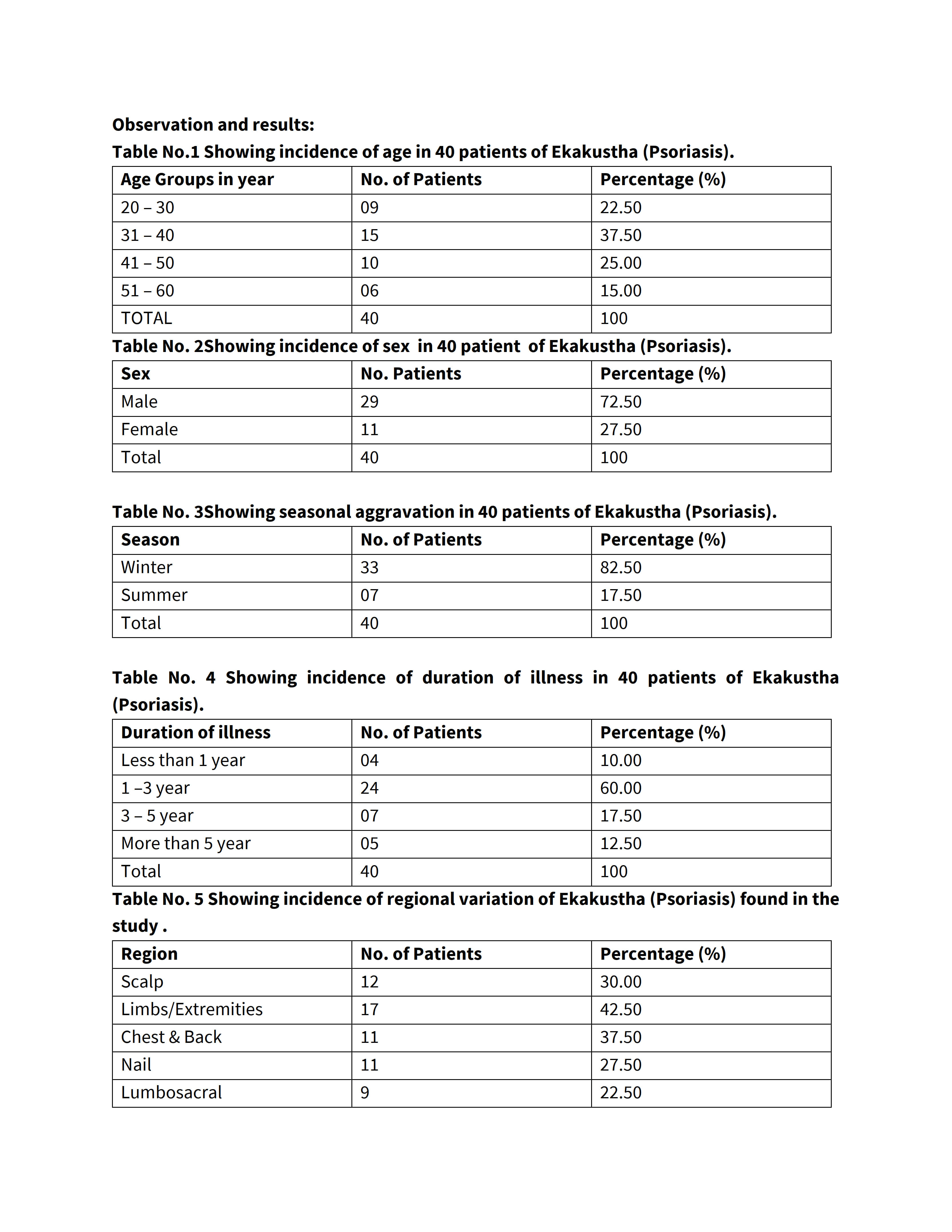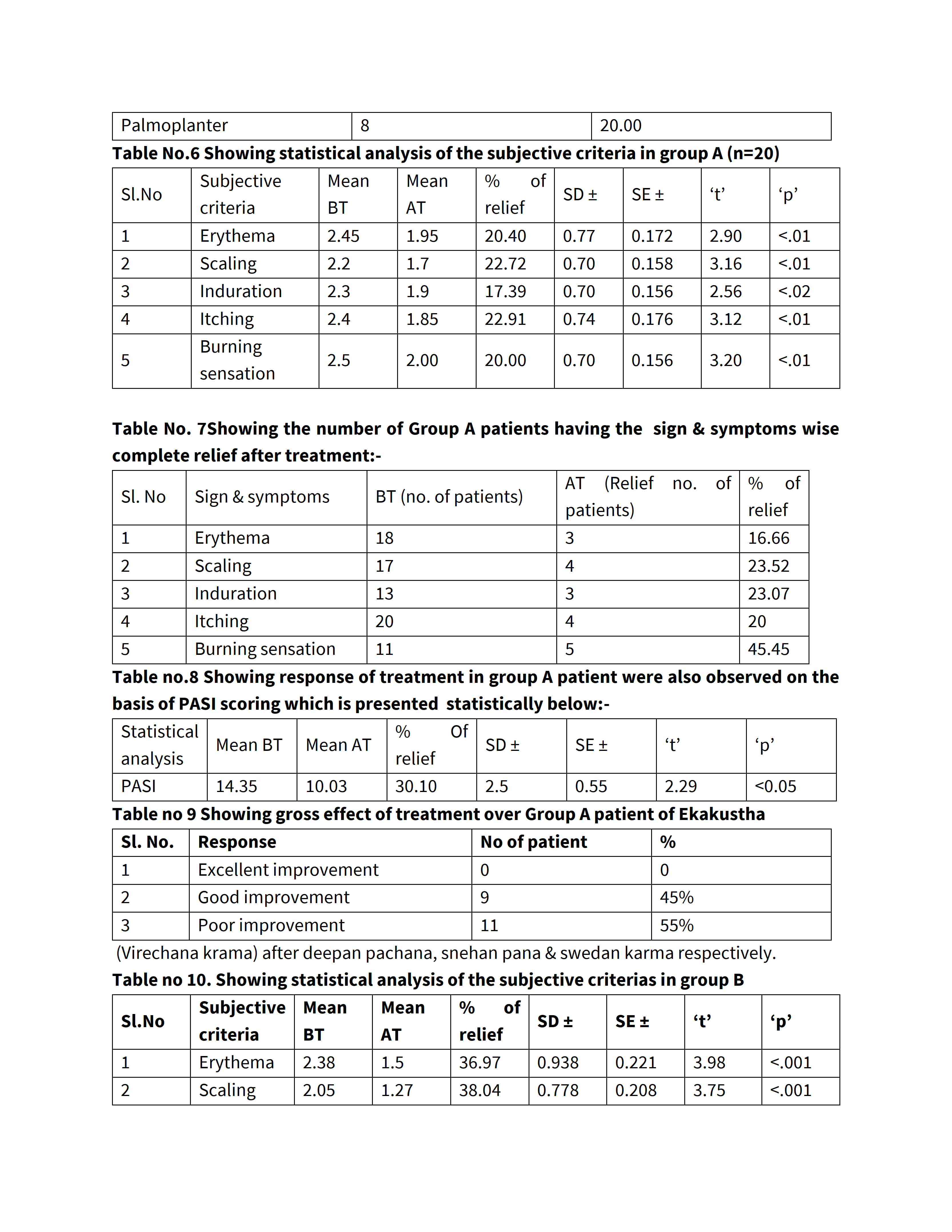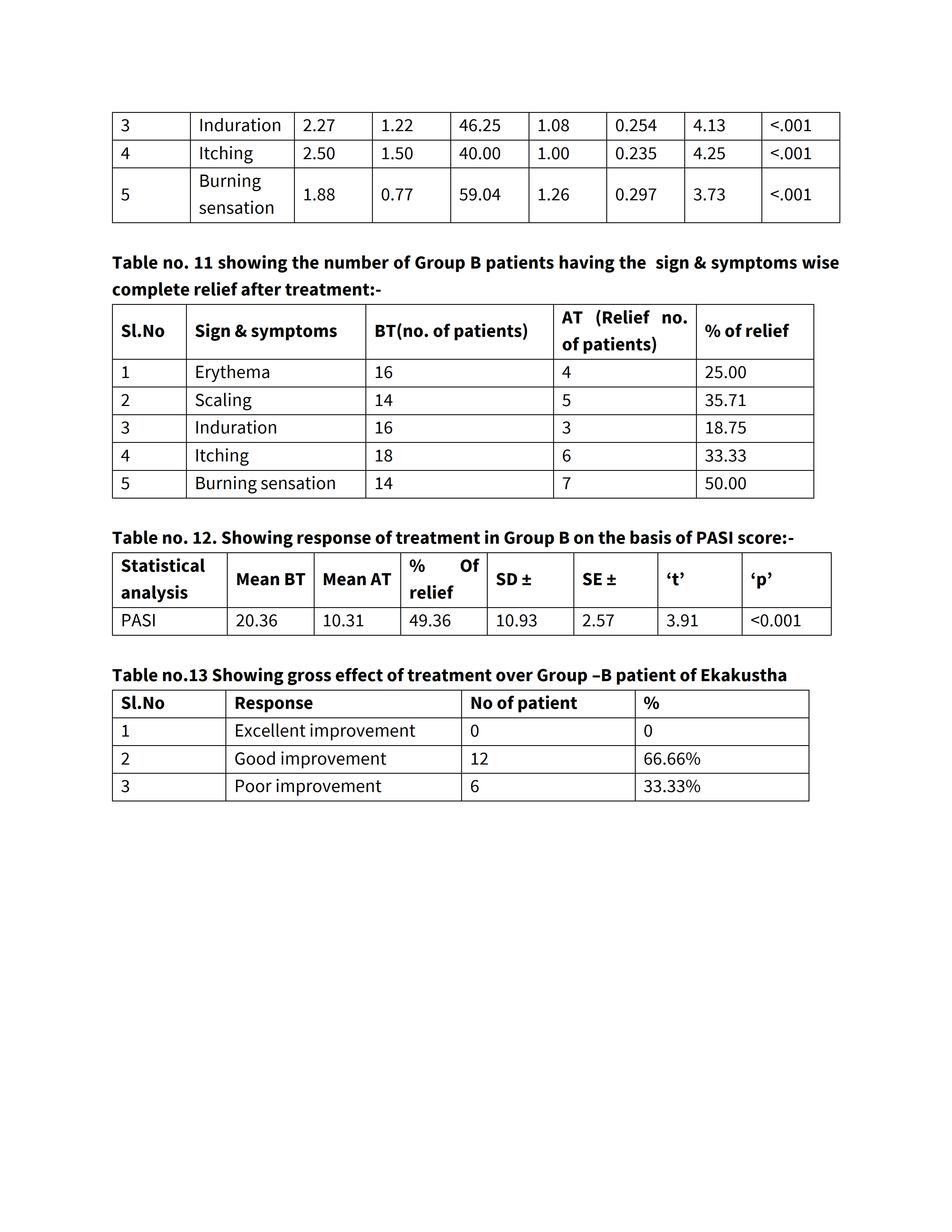Review Article
Year: 2022 |Volume: 3 | Issue: 03 |Pages: 14-26
A Clinical Study on The Management of Ekakustha (Psoriasis) With Shaman and Shodhan Therapy.
About Author
Correspondence Address:
Dr. Swati Debnath Institute of Post Graduate Ayurvedic Education & Research, Shyamadas Vaidya Shastrapith Hospital, Kolkata , West Bengal dr.swatidebnath.in@gmail.com
Date of Acceptance: 2022-03-07
Date of Publication:2022-04-23
Article-ID:IJIM_153_04_22 http://ijim.co.in
Source of Support: Nil
Conflict of Interest: Nil
How To Cite This Article: Debnath S. A. Clinical Study on The Management of Ekakustha (Psoriasis) With Shaman and Shodhan Therapy. Int J Ind Med 2022;3(3):14-26 http://doi.org/10.55552/IJIM.2022.3303
Abstract
Background: Sodhan therapy is needed prior for cleansing and washing of the channels (srotas) of our body. In present study, two groups have been categorized, where group A treated with Guduchi-Sariva-Khadira yoga internally, and Coconut oil-based Manjistha externally for 8 weeks. Simultaneously group B patient treated with the said medication after being purified with Trivrit churna and Eranda Taila. Aim & objectives :To provide safe ,effective & unique curative regimen against the incurable ailment Eka Kustha.To evaluate the efficacy of Guduchi-Sariva -Khadir-Yoga orally along with the local application of coconut oil based Manjistha.To evaluate the effectiveness of Virechan Karma prior to oral & local therapy of medicaments. Methods: The sample have been divided into 2 groups, Group – A & Group – B. Guduchi-Sariva-Khadira orally & coconut oil based Manjistha for local use have been given to 20 patients. Virechan Karma as per ethical norm followed by Guduchi-Sariva-Khadira-Yoga orally & coconut oil based Manjistha locally to another 20 patients. Results and Conclusion: Sodhan therapy followed by saman therapy is much more effective in Ekakustha (Psoriasis) than the only Samana therapy.
Keywords: Samana, Sodhan, Ekakustha , Kshudrakustha, Guduchi-Sariva, Virechan
Introduction
In Ayurveda, chikitsa is broadly classified into two (2) Sodhana (eliminatory) and Samana (pacificatory). Sodhan occupies the first place and question may be raised why so much important given to Sodhan Chikitsa. Sodhan therapy is needed prior for cleansing and washing of the channels (srotas) of our body. Specially in chronic ailments Sodhan therapy is very much indicative as in Ayurveda, kustha is a long-standing condition where vitiated Rakta leads to disfiguration of the body. Ekakustha is a type of Kshudrakustha which is characterised by absence of perspiration, extensive localisation and it resembles like scales of fish. These signs and symptoms are more or less similar to the psoriasis in Modern sciences. In modern medicine there is no any satisfactory treatment available for psoriasis, after taking modern medicine patient only suffer and there is a recurring nature of the disease., hence the present scenario is frustration of patients for such longstanding, worst, cosmetic topical hazards and physician are feeling hopeless towards the remedies. In such condition, the present work is an honest effort to bring some solution through some Ayurvedic Sodhan as well as Saman therapy. So, in present study two groups have been categorized as their treatment schedule, where group A treated with Guduchi-Sariva-Khadira yoga internally, and Coconut oil based Manjistha externally for 8 weeks. Simultaneously group B patient treated with the said medication after being purified with Trivrit churna and Eranda Taila.
Aim & objectives :
-
To provide safe ,effective & unique curative regimen against the incurable ailment Eka Kustha.
-
To evaluate the efficacy of Guduchi-Sariva -Khadir-Yoga orally along with the local application of coconut oil-based Manjistha.
-
To evaluate the effectiveness of Virechan Karma prior to oral & local therapy of medicaments.
-
To study the complications if any during the course of treatment.
-
To study systemic adverse effects if any during oral or local use of medicine & Virechan Karma.
STUDY SITE: Sufficient number of patients of Eka Kustha (Psoriasis) have been selected from OPD of IPGAE & R at S.V.S.P,Kolkata-9 on the basis of careful history taking clinical examination.
STUDY PERIOD: 1 and ½ years.
SAMPLE SIZE: 40 patients.
SAMPLE DESIGN: The sample have been divided into 2 groups, Group – A & Group – B. Guduchi-Sariva-Khadira orally & coconut oil based Manjistha for local use have been given to 20 patients. Virechan Karma as per ethical norm followed by Guduchi-Sariva-Khadira-Yoga orally & coconut oil-based Manjistha locally to another 20 patients.
SELECTION OF PATIENTS:
Inclusion Criteria:
-
Age : 20-60 years of either sex
-
Cardinal Symptom of Eka Kustha like absence of perspiration extensive localization & it resembles the scales of fish etc.
-
Positive signs of Psoriasis like Auspitz’s sign, candle grease sign
-
Patients are not under other medicine for Psoriasis
-
Patients who had agreed to follow the study protocol & give consent for the clinical trial
Exclusion criteria :
Patients suffering from systemic disease like diabetes mellitus, cancer, AIDS, Tuberculosis etc & other skin diseases like Seborrheic dermatitis, Lichen simplex etc.
Drug induced skin lesion.
Assessment of results :The effectiveness of the therapy was assessed on the basis of subjective criteria before & after treatment.
- SUBJECTIVE PARAMETERS:
The subjective criteria depends on 5 chief cardinal features.
-
Errythema
-
Induration
-
Scaling
-
Burning sensation
-
Itching
A scoring method as per the PASI (Psoriasis area & severity index) scale of New Zealand Dermatological Society (Derm Net NZ).The severity to be measured on Erythema, induration & scaling to be measured on a scale of 0-4, from none to maximum. The calculation to be made as per PASI.
PREPARATION OF MEDICINES:
All the herbs have been collected from the market after proper recommendation and identification by the Ayurvedic experts. Guduchi–Sariva-Khadira-Yoga : The dried & cleaned Guduchi stem, Sariva root and bark of Khadira to be taken in 3:2:1 ratio and powder have been made. One litre Coconut oil have been taken in an iron vessel and boiling to be continued till the bubbles have disappear. Then 65 gm Manjistha powder to be added in kalka form with the oil & again continue boiling with low fumes (Mridu Paka) for 15 mins. Then oil to be made cool and after that filtering to be done.Sunthi, Marich & Pippali have been taken in equal quantity that is. 1:1:1 ratio. Then dry them and make it powder form.Gabya Ghrita (pure) collected for Abhyantar Snehan Karma.Eranda Taila (pure) and Trivrt churna collected for Virechan Karma.
STUDY TECHNIQUE :
Following techniques have been perform for individual
GROUP A : Total 20 Patients have been included in this group
Oral use
Drug-Guduchi-Sariva-Khadira -Yoga
Dose-3 gm twice a day
Time-Before breakfast & evening tiffin
Duration-8 weeks
Anupan- plain water with
Local application
Drug- coconut oil based Manjistha
Dose-as much as required
Time-twice daily in early morning and afternoon
Duration-8weeks
GROUP B:
Total 20 Patients have been included in this group
Virechan Karma-
- Deepana pachan – with Trikatu churna
- Snehan Karma:
Achchha pan with pure Gobya ghrita to be continued in ethical manner till samyak snehan lakshan appear.
- Swedan Karma:
After Snehan, swedan karma have been done with Guru pravaran swedan (approx 40 mins with 10 blankets)
- Virechan Karma have been done in ethical manner with Eranda taila and Trivrt churna (dose depends on the Rogi bala ,Roga bala and Kostha.
- Samsarjana Krama have been done accordingly in ethical manner for 7 days as mentioned in therapy review chapter of this thesis.
After Samsarjana kram the aforesaid oral medicine and local application of oil to be continued for 8 weeks as mentioned in Group A patients.
Subjective parameters :
Assessment of improvement of psoriatic lesions following treatment was based on a clinical evaluation. The subjective criteria depending on five chief cardinal symptoms i.e., itching, erythema, scaling, induration, and burning sensation were assessed grossly. Again each symptom was assessed following the scoring method as per the PASI scale of New Zealand dermatological society (Derm Net NZ) which is noted below.
Erythema : 0 absent
- mild
- moderate
- severe
- very severe
Scaling : 0 absent
- mild (scaling by rubbing/by itching)
- moderate
- severe
- very severe
Induration: 0 absent
- mild
- moderate
- severe
- very severe
To understand overall effect on psoriasis, the psoriasis area and severity index (PASI) scoring method was adopted as follows :-
For the PASI, the body is divided into four sections, each of these areas is scored by skin itself and then the four scores are combined into the final PASI.

img 1

img 2

img3
Discussion
Kustha broadly classified into two categories where first category Maha Kustha contains seven varieties and simultaneously second category that is Kshudra Kustha remains with its eleven varieties. Ekakustha is one of the varieties of Kshudra Kustha which is characterized by absence of perspiration, extensive localization and resembles the scales of fish. These causative factors provoked Tridosa – Vata, Pitta and Kapha which in turn involved the four bodily elements viz. Tvak, Rakta, Mamsa, Lasika. These four Dusyas become morbid and loose their characters. Those provoked Dosas settles themselves into the vitiated body elements and getting localized. Further those vitiated Dosas are affecting the body element to produce Kustha. The trial drug Guduchi- Sariva- Khadir yoga consists of three herbs namely Guduchi (Tinospora cordifolia), Sariva (Hemidesmus indicus), Khadira (Acacia catechu). The combination of these three has been taken orally. So vivid literally descriptions have been done through ancient literatures as well as Nighantus [special texts of Dravya Guna Vigyan]. Botanical name, family, synonyms, habitat, morphological characters, active principles, pharmacodynamics [rasa, guna, virya, vipaka], therapeutic use as well as indications, dose, parts use of these drugs have been mentioned vividly. Guduchi posses the katu, tikta, kasay rasa; guru-laghu guna, usna virya and madhura vipaka. It is a potent pitta shamak and samsamaniya dravya. It is useful in the treatment of daha, vrana, krimi, pandu and twak vikara. It is found to be a good immune modulator. Sariva has the rasa like madhur, tikta; guna – guru, snigdha and sita virya. It is also a potent pitta vata nashak drug useful in treatment of visarpa, raktapitta, kustha etc. Khadira having the rasa tikta, kasaya; guna – laghu; virya – sita; and vipaka katu. It is also a potent pitta kapha hara dravya useful in the treatment of vrana, svitra, other twak roga. Beside the said oral medicine a local application also been used in this clinical trial where coconut based manjistha oil has been given. Manjistha also is a rakta sodhak and twak roga nashak agent. Coconut oil produces the soothing and healing affect over skin. As Virechana karma has been performed in present study, so in purva karma, trikatu churna (sunthi, pippali and marich) has been used in the present trial. Review of these three drugs has been done thoroughly where dipan, pachan and grahi action of these drugs have been revealed from the ancient literatures. Before Virechana karma, Snehapana done with Gavya ghrita. So, review of literatures in relation to gavya ghrita has been done where pitta shamaka, deepan, varna prasadan and snehana action has been revealed. The Virechan karma done with trivrita churna and Eranda oil. So the elaborated review of those herb has been done methodically. The Trivrita (Operculina turpethum) belongs to the English name Indian Julap and it is a variety of trivritta known as sweta or aruna trivritta. It bears the rasa – tikta, madhura; guna like sara, ruksha, snigdha, usna and useful as rechak dravya and jwaranashak. Eranda (Ricinus communis) is a potent virechak useful in vibandha, amavata, kati shul, vata rakta, and kustha. Guduchi – Sariva – Khadira Yoga is an affective oral medicine and showed its efficacy in the treatment of Psoriasis along with the external application of coconut oil based Manjistha. . So the purificatory measured or Sodhana therapy has significant role in the treatment of Ekakustha that is probably due to Srotoshodhan (cleansing of channels). The morbid Dosas which are in Sakha that comes to Kostha, and eliminated through Virechan karma. By this process, Dosa Vaisamya and dhatu dusti is reduced. So the observation of such clinical study clearly suggest that Ekakustha or Psoriasis like chronic, incurable or difficult to cure ailment should be treated with Sodhana karma and later Saman therapy may show the better response than the only Saman therapy.
Conclusion
The Sodhan therapy specially Virechan karma with Trivrit Churna and Eranda taila followed by Saman therapy with Guduchi – Sariva – Khadira Yoga 3 gm twice daily before food and coconut oil-based Manjistha locally for 8 weeks which administered in group B patients able to show the significant good response about 67%, Only Saman therapy with Guduchi – Sariva – Khadira Yoga 3 gm twice daily before food and coconut oil-based Manjistha locally for 8 weeks, able to show 45% good response. Sodhan therapy followed by saman therapy is much more effective in Ekakustha (Psoriasis) than the only Samana therapy.
References
- Kunte Anna Moreswar, Sarbangya sundar tika on Astanga Hridaya by Sri Arun Dutta, Krishna das Academy,Varanasi,reprint 1995, nidan sthan 14/3, page no -524.
- Tripathi B. Amar singha, Amar kosh, Enlarged with Anekarthaadhavani manjari hindi commentary, Chaukhambha Surabharati Prakasan,2004 Ramashramitika-2/6/54.
- Tripathi Brahmanand, Astanga Hridayam of Srimadvagbhata, Chowkhambha Surabharati pratisthan, Delhi, Reedition 2003, Nidan sthan 14/4. page no-527.
- Tripathi Brahmanand, Caraka Samhita of Angives, Chowkhambha Surabharati Prakashan, Varanasi, Reedition-2011, Vol -2, chikitsa sthan-7/1-2, page no299.
- Maharshi Vedavyas Agnipuran, Edited by Acharya Baladeva Upadhya, chowkhamba publication,Varanasi, page no-412.
- Tripathi Brahmanand, Caraka Samhita of Angives, Chowkhambha Surabharati Prakashan, Varanasi, Reedition-2011, Vol2-1, chikitsa sthan, 7/125. page no-324.
- Tripathi Brahmanand, Caraka Samhita of Angives, Chowkhambha Surabharati Prakashan, Varanasi, Reedition-2011, Vol-1, sutra sthan,18/6. page no-369.
- Tripathi Brahmanand, Caraka Samhita of Angives, Chowkhambha Surabharati Prakashan, Varanasi, Reedition-2011, Vol -2, chikitsa sthan, 7/9. page no-301.
- Tripathi Brahmanand, Caraka Samhita of Angives, Chowkhambha Surabharati Prakashan, Varanasi, Reedition-2011, Vol -2, chikitsa sthan 25/59. page no-849.
- Tripathi Brahmanand, Caraka Samhita of Angives, Chowkhambha Surabharati Prakashan, Varanasi, Reedition-2011, Vol -2, chikitsa sthan 25/106. page no-858.
"

